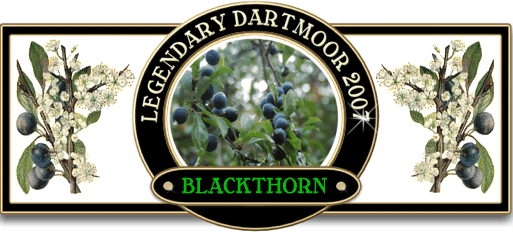
“When winter comes in earnest to fulfil
His yearly task at bleak Novembers close,
And stops the plough and hides the fields in snows;
When frost locks up the streams in chill delay
And mellows on the hedge the purple sloes …“.
John Clare – The Shepherd’s Calendar – 1827
Prunus spinosa – now there’s a name to conjure with, or if you prefer the humble hedgerow blackthorn. This small tree can be found in many of the hedgerows of Dartmoor and even in some places on the exposed slopes of the high moor. Although it is always nice to see the early white blossom heralding the arrival of spring it is much nicer to eye up the matt black berries as they begin to ripen with their promise of sloe gin later in the year. However, there can be nothing more evocative than walking down a lane on a breezy late spring day when the small, delicate white petals are gently wafting in the air and carpeting the lane in white confetti. But as with most hedgerow plants the blackthorn has a wealth of superstition attached to it along with some curative powers and timeless traditions.
In local folklore the blackthorn is regarded as something of an unlucky tree because of the tradition that it was from this tree that Christ’s crown of thorns was made. In this light it was deemed to invite misfortune if any part of the tree was brought into the house. Medicinally, the bark of the blackthorn tree was said to cure bronchitis when boiled in water and drunk cold. The actual timber has never been used for much other than making walking sticks, however the bark has been utilised for making a yellow dye and writing inks. Because of its natural denseness and sharp thorns the tree does make a good stock proof hedge, hence its occurrence around agricultural land. The thorns can cause a vicious wound if not removed and there is mention of an old charm used to stop such an injury festering –
“Christ be a virgin’ born,
And twas pricked by a thorn,
Thik thorn never did a swell
And I trust in Jesus this ‘un never will.”
On parts of the fringes of the south-eastern moor it was believed that a cure for boils was to crawl around a blackthorn tree backwards for three times whilst the dew was still on the grass. The dried blackthorn leaves were unscrupulously used to adulterate Chinese tea, it has been suggested that around 1835 4 million tons of leaves were being mixed in with Chinese leaves and sold as genuine tea. Shortly after a bill was passed by Parliament which allowed the practice to continue provided the ‘blend’ was called, “English Tea”. The arrival of the blackthorn blossom has been said to herald a following cold snap of weather or a, “blackthorn winter”.
Yesterday I was walking down a lane and saw the blackthorn bushes with this years crop of slones and this reminded me of sloe gin. A few months ago we held a party for some neighbours one of which brought a bottle of his homemade sloe gin along. Half a bottle later I was sending out an invitation to the Tavistock Badger to come a-calling and sure enough the next morning I felt his calling card. Anyway, at a later function is was decided to have a sloe gin making competition to see who can produce the best bottle of jollup for Christmas 2008. Therefore I have been delving through numerous old family recipe books for a suitable recipe and have, for anyone else who would like a lash, put the winning formula below:

SLOE GIN 2007
Apparently it is best to pick the berries around October time or after the first heavy frost which in these days of global warming will be about February time. But if you want to be drinking the stuff at Christmas then October is the optimum time to make it. It seems to me that if a true Dartmoor brew is to be made, then as its water comes from the moor, only Plymouth Gin should be used.
INGREDIENTS (makes 1 litre of jollup)
450g (1lb) of Slones
225g (8oz) of Caster Sugar
1 litre (1¾ pints) Plymouth Gin
METHODOLOGY
1. Prick the skins of the slones with a needle or fork and place in a large, clean jar. A cider flagon is ideal.
2. Sprinkle the sugar over the sloes and add the Plymouth Gin, seal tightly and thoroughly shake.
3. Store in a cool, dark place and shake well every other day for a week.
4. Subsequently, shake once a week for two months
5. If the slone gin is required, remove the slones and let the cloudiness and sediment settle for two days and then decant the clear liquid into a clean bottle. If after a couple of weeks the gin is still cloudy – repeat the process.
6. When you get the final fine sediment pour the gin through a coffee filter and then enjoy, but just remember that the Tavistock Badger is watching!
 Legendary Dartmoor The many aspects past and present of Dartmoor
Legendary Dartmoor The many aspects past and present of Dartmoor

Hi Tim. I’m local to the Tavistock area. any ideas on where on Dartmoor I might find sloe berries this year? Wanting to make some sloe gin as Christmas gifts 🙂 thanks in advance